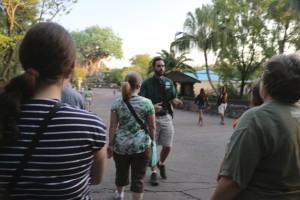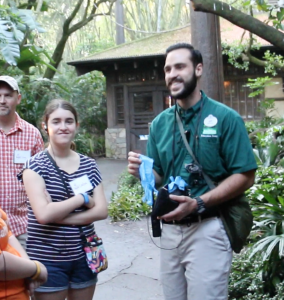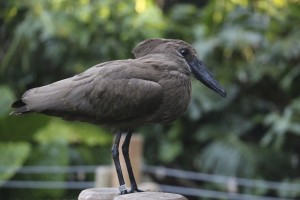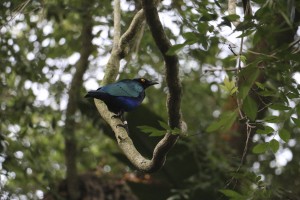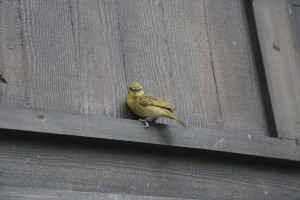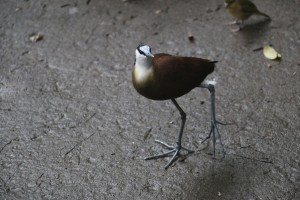Disney’s Animal Kingdom Backstage Tales Tour Review
Earlier this year, Disney discontinued two of their behind-the-scenes tours at the Animal Kingdom (Backstage Safari and Wild by Design) and replaced them with a new tour called Backstage Tales. The new tour a mashup of the two, weighted heavily with Backstage Safari experiences. If you’ve previously been on Backstage Safari, consider yourself covered.
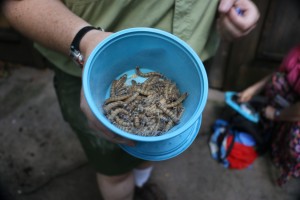
A key difference between the old tours and the new is a change of the participation age limit. Backstage Safari (which, not surprisingly, took place backstage) had an age requirement of 16. Wild By Design (which was an on-stage experience) had an age 14 requirement. The new Backstage Tales allows guests as young as 12 years old to participate. I took the tour with my 15 year old twin daughters.
Disney used standard-sounding boilerplate language when they described why the tour was changed — something along the lines of “due to guest feedback and demand.” While I’m sometimes suspicious of the real motivation behind comments like that, I can assure you that when answering questions on the Disney Parks Moms Panel, we did indeed get many questions from guests requesting behind-the-scenes educational experiences for their younger children. The reduced age requirement is terrific news for budding veterinarians and zoologists who want an early look at the inner workings of animal care at the park.
The tour consists of seven parts:
- Introductions and Getting to Know You
- Visit to the Aviary (Pangani Forest Trail area)
- Visit to the backstage rhino and elephant habitats
- Break time and snack, with presentation by animal care specialist
- Visit to the animal nutrition center
- Visit to the backstage area of Conservation Station, including an animal operating room
- Visit to the backstage komodo dragon habitat
Introductions and Getting to Know You
This tour starts early, 7:30am. While younger teens will enjoy getting to see the backstage areas, they will almost certainly NOT like the early hour. Theoretically, you should be able to get an “early character meal” bus from your resort to the Animal Kingdom, but I wouldn’t risk it. If you’re going to take this tour, plan to get to the park with your own car or via a taxi or Uber. Also note that the food cart outside the park gates may not be open when you arrive. You should grab breakfast at your hotel prior to leaving for the tour.
Guest check-in takes place just outside the park gates, toward the left as you face the park. There’s a bit of housekeeping when you arrive. Adults must sign waivers for themselves and any children in their care. Also, IDs are checked for adults. All guests are issued name tags and audio headsets that make it easier to hear the guide’s narration.
Your guide will introduce him or her self, giving a brief synopsis of where they’re from and their history with Disney. They will then ask the guests to introduce themselves, giving their name where they’re from, and some other bit of information. On various tours, I’ve been asked to tell my favorite Disney character, my favorite ride, my favorite animal, or what I’m looking forward to about the tour.
Once the business is out of the way, guests pass the park gate touchpoints using their admission media. (I was going to say swipe their tickets at the turnstile, but that’s so 2013.)
Visit to the Aviary (Pangani Forest Trail area)
The first stop on the tour is at the Pangani Forest Trail aviary. Along the way, the guide will share stories about the history of the Animal Kingdom park. Some of these are the same as what I encountered when I took the Wild By Design tour in 2014. Photography is allowed on the AK park paths and in the aviary, which is a public space.
At the aviary, we were greeted by a bird care specialist. He discussed the nesting and feeding habits of many of the species housed at the Animal Kingdom. A highlight for several guests was an opportunity to feed the birds by tossing mealworms to them. Guests who chose to do this were offered gloves, if they wanted to use them. The mealworms made our group extremely popular with the birds, making this a terrific opportunity to get photos. The feeding also made it easier to see that all the birds at the aviary are banded with identification tags. We learned from the keepers that every bird is located and counted every day.
Visit to the backstage rhino and elephant habitats
After the aviary, we slipped behind the scenes and boarded a van to take us to the rhino and elephant barns. Before getting in the van, we were asked to put away our cameras. Most folks just slipped them into their bag or pocket. I was wearing a large DSLR and just put the lens cap on, which seemed to satisfy the guide that I wasn’t covertly snapping pictures.
At the rhino and elephant barns, we were met by a large mammal specialist who described some of the training the animals receive to facilitate their medical care. We were also welcome to ask as many questions as we wanted about life on the “savannah,” work at the Animal Kingdom, animal breeding, or anything else we could think of. The barns are spartan and much more zoo-like than the wooded areas that guests see inside the park. Backstage it’s mostly iron and concrete. The animals are given some “toys” and distractions, but the barns are primarily a business area. While at the barns, we did see elephants backstage getting cared for, but all the rhinos were out for viewing in public areas. This will vary daily depending on the needs of the animals and the facility.
Visit to the backstage area of Conservation Station, including an animal operating room
When you visit the public areas of Conservation Station (the building in Rafiki’s Planet Watch at the end of the Wildlife Express train ride), you may see animal care specialists performing procedures on creatures from behind a glass wall. On the Backstage Tales tour, you get to go into one of those rooms and see the medical equipment up close. We learned about the different types of tools used to examine different size species and got an overview of the areas of expertise of the cast members that work at the Animal Kingdom.
During our visit, we happened to see part of an examination of a sedated fennec fox. This is one of my daughter’s favorite animals, so she was in awe. You may or may not see a live animal procedure during your tour, depending on the needs of the facility.
Visit to the animal nutrition center
After another brief van ride, we stopped at the stop animal nutrition center. This is almost like the kitchen for a large restaurant. There are delivery bays for fruits and vegetables — from the exact same vendors that provide human food for the parks. The produce must meet the same exacting specifications as the food for the guests. We also got to see storage areas for hay and specially prepared pellet-style nutritional supplements for some specials. Additionally, there were freezers for the meat fed to carnivores.
The main room of the nutrition center features several work stations where staff have “recipe books” with precise measurements of food to be delivered to each animal each day. These were “plated” into individual storage containers for transportation to the feeding stations throughout the park.
A particularly interesting area was a shelf full of enhancement items to make the food more interesting for the animals. This included things like jam, peanut butter, and ground spices, which are periodically added to some animal foods to keep them interesting.
Break time and snack, with presentation by animal care specialist
Near the nutrition center, we visited a classroom area in the backstage education building. We were given an opportunity to use the restroom. Then we were provided with snacks (rice krispie treats) and given souvenir metal Animal Kingdom water bottles, which we could fill from a bottled water cooler.
While we snacked, we were visited by a conservation specialist. Our specialist spoke primarily about Disney’s efforts to support the wild sea turtles near the Disney Vacation Club resort in Vero Beach, Florida. We learned about turtle reproduction and migration patterns. This talk didn’t have much to do with the Animal Kingdom park itself, but it was a good opportunity to learn about Disney’s dedication to conservation issues, and to get out of the heat for a few minutes.
Visit to the backstage komodo dragon habitat
Our final stop was the backstage habitat of the Animal Kingdom’s komodo dragons. We watched a dragon trained to be step onto a scale to be weighed. When the dragon performed the desired behavior, he was rewarded with a “fuzzy,” a frozen baby mouse. The behaviors of the dragons, and all the animals, is completely voluntary. They are rewarded for compliant behavior, but they are never punished for non-compliance.
At the dragon habitat, as at every stop, we were allowed to ask as many questions as we wanted about animal care and behavior, Animal Kingdom operations, or staff training. The Backstage Tales tour is particularly nice because it’s one of the few behind-the-scenes opportunities for guests under the age of 16. If you have a child interested in a possible career in animal care, this is a unique chance to see what their future might be like. In my opinion, the price is reasonable for the amount of time and personal attention you get from the professional staff.
The Details
- The price is $90.00 per person, plus tax. All ages pay the same price. Disney Vacation Club, Annual Pass Holder, or Disney Visa Holder discounts may be available. Inquire at time of booking.
- Theme park admission is required and not included in the price of the tour.
- There is a 48 hour cancellation policy. You will be charged the full price of the tour if you no-show or cancel less than 48 hours before your tour.
- The tour takes place from 7:30am to about 11:15am daily. The tour may not be conducted during holidays and during special events.
- The tour takes place substantially outdoors, rain or shine. Come prepared for the weather.
- Open to guests ages 12 and up. Guests ages 16 and up will need to provide photo ID. Children under age 18 must be accompanied by a paying adult.
- Reservations must be made in advance, over the phone. Call 407-WDW-TOUR (407-939-8687).
- Photography is not allowed during backstage portions of the tour. You make take photos during the on-stage portions of the tour.
- Meet outside the gates to the park 15 minutes prior to start time.
- Guests are given audio headsets to better hear the guide while walking through the park.
Have you been on the Backstage Tales tour? Is this something you’re considering for you or your kids? Are there any questions you have? Let us know in the comments below.

